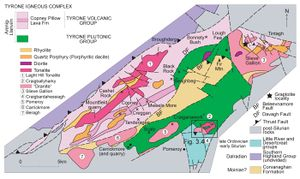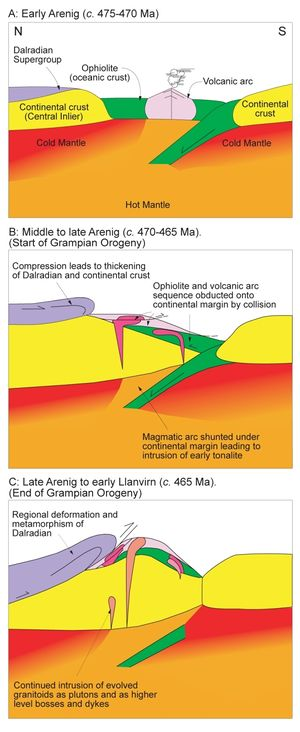Tyrone Igneous Complex, Midland Valley Terrane, Northern Ireland
| Mitchell, W I (ed.). 2004. The geology of Northern Ireland-our natural foundation. Geological Survey of Northern Ireland, Belfast. |
M R Cooper and W I Mitchell
Tyrone Plutonic Group
















The Tyrone Plutonic Group forms the southern half of the Tyrone Igneous Complex (P947794). In the northeast part of its outcrop the rocks consist mainly of variably tectonised and metamorphosed gabbro and hornblende gabbro [1] with both layered and isotropic varieties present. Dolerite, in the form of a sheeted dyke complex, appears confined to the southwest around Carrickmore [2]. This association of rock types and their field relationships strongly supports the idea that they represent the upper layers of an ophiolite (P947795).
Gabbros, with cumulate layering [3] reflecting textural and compositional variations, form ice-scoured knolls at Scalp [H 635 745] northeast of Carrickmore (P947794). Metre-scale and centimetre-scale layering is composed of alternating dark mafic and pale felsic bands. While there appears to be no regular relationship between the bands, sections of metre-scale layering are always separated by a thin zone of monomineralic bands. At Scalp, there is every gradation from normal layered gabbro to intensely deformed gabbro resembling hornblende schist (P947967). Epidote-amphibolite metamorphic assemblages are developed without any accompanying deformation and may be the result of metasomatic alteration by circulating hot brines.
At Black Rock [H 685 837], coarse-grained hornblende gabbro is in contact with, and contains xenoliths of, an early-formed suite of dolerite and is intruded by younger, 1–2 m wide, basalt and dolerite dykes (P947968) and (P947969). Also of note here, is the irregular form of intrusions and veins of pegmatitic gabbro. This assemblage of cross-cutting rock types may have formed in a transitional zone between a plutonic magma chamber and the sheeted dyke complex during the formation of the ophiolite. Intrusions of porphyritic granitoid and fine-grained dacite also invade the gabbro and dolerite (P947970). The sheeted dyke complex, which is best exposed in Carrickmore quarry [H 609 721], consists of parallel, northeast-southwest trending dolerite dykes that are either vertical or dip steeply southwards [4]. The dykes average 1 m in thickness and intrude one another forming two-sided chilled margins, and more commonly, one-sided chilled margins that are characteristic of sheeted dyke complexes.
Tyrone Volcanic Group
The Tyrone Volcanic Group consists of volcanic, volcaniclastic and thin, occasionally fossiliferous, argillaceous sedimentary rocks (P947794). Its outcrop is bounded in the north by the Omagh Thrust Fault and by the Beleevnamore and Davagh faults in the south.
Within the Tyrone Volcanic Group there is evidence of at least three volcanic cycles. The base of each cycle is defined by a basic volcanic component, composed largely of pillowed basaltic lavas, while at the top are laminated chert, jasper and black mudstone. The background lithology consists of pale-greenish grey, schistose, chlorite-epidote-sericite tuff which range from fine-grained ash to coarse-grained lapilli tuff. The Group also contains clast- and matrix-supported volcanic breccias composed of angular and rounded fragments of rhyolite and dacite in a tuffaceous, or more rarely, ignimbritic matrix. The deposits are laterally impersistent and most likely formed close to explosive vents. Rock crags southeast of Beaghbeg [H 674 828] are formed of coarse-grained lapilli tuff with isolated clasts up to 5 cm in diameter of angular, pale pink to grey felsite (P947971), and rare examples of banded cream coloured chert and jasper. At Creggan [H 623 782], crudely bedded, clast- and matrix-supported breccias contain numerous clasts of buff-weathering felsitic and rare fragments of basalt and jasper (P947972) and (P947973).
The base of the lowest volcanic cycle is represented by the Copney Pillow Lava Formation (P947794) which forms the prominent knolls between Copney Hill [H 600 777] and Creggan [H 623 782]. At Mweela More [H 641 792], north of the Cookstown Road (P947974), there are spectacular examples of undeformed pillow lavas consisting of fine- to medium-grained, locally porphyritic basalt (P947975). The triple junctions between some of the pillows contain pale pink to red chert or fine-grained hyaloclastite breccia. Thin layers of grey and green, banded chert occur with pillow lavas at the base of the southernmost crag at Mweela More (P947976).
The top of the lowest cycle is represented by the Tanderagee Siliceous Ironstone Formation [2] which is exposed at Tanderagee [H 624 763] (P947794) and consists of thin beds of jasper and banded chert. The top of the second cycle is represented southwest of Bonnety Bush [H 726 888] by a bed of jasper at least 1m thick, with millimetre-scale banding, interbedded with pale green and grey tuffs and laminae of black mudstone. The occurrence of beds of black chert and graphitic pelite at Broughderg [H 671 878] may represent the top of the third cycle (P947794).
A small exposure of dark grey to black, graphitic mudstone in Sruhanleanantawey Burn [H 791 878] on Slieve Gallion contains fragments of the graptolites Tetragraptus serra and Sigmagraptus s.l. [5]. They indicate a Lower Ordovician (Arenig to Llanvirn) age for the mudstone and, by implication, for the surrounding volcanic rocks of the Tyrone Volcanic Group.
Each cycle thus commences with submarine lavas. The succeeding volcaniclastic rocks are largely of submarine origin but may include a minor subaerial component. The laminated chert and jasper probably accumulated in a volcanic environment as colloidal gel deposited within the surrounding tuffs. At a later stage, as water levels deepened within the basin, black mudstone was deposited in quiet euxinic conditions during periods of reduced volcanic activity. As a single succession of volcanic and sedimentary rocks, the Tyrone Volcanic Group becomes progressively more acidic from base to top while within each cycle there is a trend from basic to acidic between the base and top. These cycles are believed to have been active in an island arc or back-arc setting on the northern margin of the Iapetus Ocean ((P947796) A).
The Tyrone Plutonic and Tyrone Volcanic groups are intruded by a small number of arc-related, early Caledonian intrusions [6]. While these plutonic intrusions of tonalite, granodiorite and granite mostly cut the Central Inlier and ophiolite, related higher level bosses, sills and dykes of porphyritic dacite and rhyolite are restricted to the volcanic arc sequence. These field relationships suggest that the ophiolite and volcanic arc sequence were already obducted over the Central Inlier prior to the intrusion of these intrusives (P947796)B and (P947796)C.
The Laght Hill Tonalite (P947794) is a high-level intrusion consisting of three interconnected sill-like bodies. At Cashel Rock [H 600 808], the greenish grey, coarse-grained tonalite is composed of white quartz, pale grey plagioclase (altered to white mica) and green hornblende. The rock contains a penetrative fabric. Tonalite at Cashel Rock is intruded by weakly flow-banded rhyolites that are identical to silicic clasts found in the volcanic breccias of the Tyrone Volcanic Group. The rhyolite also contains partially assimilated xenoliths of tonalite.
At Craigballyharky and Craigbardahessiagh (P947797), the relationship between the later intrusions of tonalite, granodiorite and gabbro and the older basaltic pillow lavas of the Tyrone Plutonic Group (P947797) is evident. West of the summit of Craigballyharkey [H 734 756], coarse-grained pinkish white tonalite is composed of altered feldspar (60%), quartz (30%) and hornblende (7%). Between the gabbro and tonalite, quartz-diorite is present and consists of reduced sodic plagioclase feldspar (25%), hornblende (25%) and increased quartz (45%). However, the suggested magma mingling relationship at Craigballyharky, between tonalite and gabbro [7], [4] is not convincing. Diffuse boundaries between the tonalite and host gabbro appear to be the result of erosion of a sheeted rock association (P947977). At the diffuse contact, ocelli comprising quartz megacrysts appear to have moved from the quartz-diorite into the gabbro [7]. In addition, hornblende coronas developed on the megacrysts are more likely to be the result of post-crystallization metasomatic growth. Although sharp contacts are commonly observed between the tonalite and gabbro, the absence of a chilled margin to the younger tonalite intrusion suggests that at the time of its intrusion the ophiolite was hot but not molten.
The slightly younger, very coarse-grained Craigbardahessiagh granodiorite [H 722 743] is composed of equal proportions of brown turbid feldspar and quartz with minor biotite and hornblende (10%).
The four granite plutons at Beragh, Carrickmore, Pomeroy and Slieve Gallion are petrographically similar (P947794). The pinkish grey Pomeroy granite exposed at Craiganawork [H 677 759] is typical of the group and is composed of large crystals of alkali (35%) and plagioclase feldspar (25%), biotite (5%) and quartz. A coarse northeast-southwest trending fabric dips steeply to the northern boundary of the pluton and is defined by ribbons of large quartz grains. On Slieve Gallion, the undeformed pinkish red, biotite granite exposed at Tintagh [H 810 872] is in contact with pink, porphyritic rhyolite.
The Cushendun Granodiorite is located 2 km northwest of Cushendun in Co. Antrim (P948095). It is exposed on Cushleake Mountain [D 233 434] where petrographically the rock is a porphyritic dacite (fine-grained granodiorite) composed of euhedral phenocrysts of zoned plagioclase feldspar (40%), quartz (4%) and biotite (<1%) in a fine-grained groundmass of anhedral quartz and alkali feldspar (40%). Hornblende commonly occurs as clusters of small prisms which may be xenoliths. A K/Ar biotite age of 462±6Ma [8] suggests that emplacement was contemporaneous with the arc-related magmatism of the Tyrone Igneous Complex.
References
- ↑ Geological Survey of Northern Ireland, 1995. Draperstown, Northern Ireland Sheet 26. Solid Geology. 1:50 000. (Keyworth, Nottingham: British Geological Survey).
- ↑ 2.0 2.1 Geological Survey of Northern Ireland 1979. Pomeroy, Northern Ireland Sheet 34. Solid Geology. 1:50 000. (Southampton: Ordnance Survey for the Geological Survey of Northern Ireland).
- ↑ Cobbing, E J. 1969. Schistosity and folding in a banded gabbro from Tyrone. Bulletin of the Geological Survey of Great Britain, 30, 89–97.
- ↑ 4.0 4.1 Hutton, D H W, Aftalion, M, and Halliday, A N. 1985. An Ordovician ophiolite in County Tyrone, Ireland. Nature, 315, 210–12.
- ↑ Hutton, D H W, and Holland, C H. 1992. An Arenig-Llanvirn age for the black shales of Slieve Gallion, County Tyrone. Irish Journal of Earth Sciences, 11, 187–89.
- ↑ Geological Survey of Northern Ireland. 1997. Geological Map of Northern Ireland. Solid Geology. (second edition). 1:250 000. (Keyworth, Nottingham: British Geological Survey).
- ↑ 7.0 7.1 Angus, N S. 1962. Ocellar Hybrids from the Tyrone Igneous Series, Ireland. Geological Magazine, 99, 9–26.
- ↑ Harrison, R K, and Wilson, H E. 1978. The granodiorite intrusion of Cushleake Mountain, County Antrim, Northern Ireland. Institute of Geological Sciences Report No. 78/7.